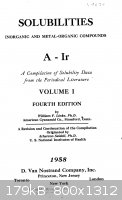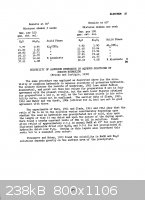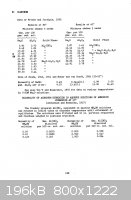Kamikaza
Harmless

Posts: 13
Registered: 17-5-2011
Member Is Offline
Mood: No Mood
|
|
Impurities in Aluminium foil
I recently dissolved some aluminum foil in a concentrated NaOH solution. This worked perfectly, because there was a decent amount of hydrogen gas
formed and it produced a lot of heat.
However insoluble grey mud-like substance was formed at the bottom of the beaker, and I have no idea what it is. I don't think it's excess aluminum,
because when the reaction was still going no hydrogen was formed on it.
My first instinct was that it was an iron impurity, so I tried to dissolve it in Fe(III)Cl3 with a little bit HCl. It wasn't iron, because there
wasn't any hydrogen formed, however, the grey mud did turn to white and the orange Fe(III) solution became yellow.
After that I tried putting it in HCl, again the mud turned white, but nothing else happened. I also tried dissolving it in a CuSO4 solution, in which
nothing happened. When I later put the grey substance in normal water, the grey turned to white yet again.
Does anybody have an idea what it can be? I have plenty of the stuff over, so I can do some extra experiments if requested.
|
|
|
Neil
National Hazard
   
Posts: 556
Registered: 19-3-2008
Member Is Offline
Mood: No Mood
|
|
Sounds like aluminum hydroxide. Aluminum foil is an alloy, the alloy materials may account for the grey.
|
|
|
Kamikaza
Harmless

Posts: 13
Registered: 17-5-2011
Member Is Offline
Mood: No Mood
|
|
Quote: Originally posted by Neil  | | Sounds like aluminum hydroxide. Aluminum foil is an alloy, the alloy materials may account for the grey. |
Shouldn't Al(OH)3 be soluble in HCl? Literatue also says that Al(OH)3 dissolves in concentrated NaOH to form Al(OH)4-. I agree with the alloy part,
but with which metals could it be alloyed and how could I test it?
[Edited on 17-5-2011 by Kamikaza]
|
|
|
redox
Hazard to Others
  
Posts: 268
Registered: 22-2-2011
Location: The Land of Milk and Honey
Member Is Offline
Mood: Chalcogenetic
|
|
How about Al2O3 (the dehydrated form of aluminum hydroxide)? Is alumina soluble in acid or base?
My quite small but growing Youtube Channel: http://www.youtube.com/user/RealChemLabs
Newest video: Synthesis of Chloroform
The difference between chemists and chemical engineers: Chemists use test tubes, chemical engineers use buckets. |
|
|
PHILOU Zrealone
International Hazard
    
Posts: 2893
Registered: 20-5-2002
Location: Brussel
Member Is Offline
Mood: Bis-diazo-dinitro-hydroquinonic
|
|
What about Tin (Sn)? Aluminium foil is also called Tin foil and it is possible that a surface treatment is done on one side of the Aluminium in a way
to reduce corrosion of the foil in contact with acidic or ammoniated food (cheeses, fruits, meat, fish...)
PH Z (PHILOU Zrealone)
"Physic is all what never works; Chemistry is all what stinks and explodes!"-"Life that deadly disease, sexually transmitted."(W.Allen)
|
|
|
hissingnoise
International Hazard
    
Posts: 3940
Registered: 26-12-2002
Member Is Offline
Mood: Pulverulescent!
|
|
For the record, alufoil for cooking is coated with ethylene acrylic acid . . .
|
|
|
Wizzard
Hazard to Others
  
Posts: 337
Registered: 22-3-2010
Member Is Offline
Mood: No Mood
|
|
FYI the aluminum foil is different textures on different sides because the last roller stage, 2 sheets are put through and compressed to the final
thickness- The sides on the rollers are smooth, the sides touching each other are less so 
|
|
|
Kamikaza
Harmless

Posts: 13
Registered: 17-5-2011
Member Is Offline
Mood: No Mood
|
|
Quote: Originally posted by redox  | | How about Al2O3 (the dehydrated form of aluminum hydroxide)? Is alumina soluble in acid or base? |
Alumina should be soluble in base, so I don't think it's alumina. This is unless all of the OH- was consumed in the reaction with aluminium.
[Edited on 19-5-2011 by Kamikaza]
|
|
|
Kamikaza
Harmless

Posts: 13
Registered: 17-5-2011
Member Is Offline
Mood: No Mood
|
|
Quote: Originally posted by PHILOU Zrealone  | | What about Tin (Sn)? Aluminium foil is also called Tin foil and it is possible that a surface treatment is done on one side of the Aluminium in a way
to reduce corrosion of the foil in contact with acidic or ammoniated food (cheeses, fruits, meat, fish...) |
It certainly could be tin, but does anybody have a idea how I can test for it?
|
|
|
Morgan
International Hazard
    
Posts: 1660
Registered: 28-12-2010
Member Is Offline
Mood: No Mood
|
|
Reynolds Wrap Products - Reynolds Wrap - Aluminum Foil, 12" x 25', 1 Roll, Silver - Sold As 1 Each - Can withstand both hot and cold foods. - Made
from 98.5% aluminum with the balance made up of iron and silicon. - Greater strength and puncture resistance.
From Amazon.com
"Since that time it has become one of the most immediately identifiable brands on the market. Reynolds Wrap Aluminum Foil is 98.5% aluminum. The
balance is primarily iron and silicon. These are added to give the strength and puncture resistance obtained only in the alloy used in Reynolds
household foil. Reynolds Wrap Aluminum Foil contains no recycled material and complies with U.S. Food and Drug Administration requirements for direct
contact with food."
http://www.reliablepaper.com/Reynolds_Wrap_Heavy_Aluminum_Fo...
[Edited on 19-5-2011 by Morgan]
|
|
|
not_important
International Hazard
    
Posts: 3873
Registered: 21-7-2006
Member Is Offline
Mood: No Mood
|
|
Morgan has it - Fe, Si, and sometimes Mn are the main alloying elements in Al foils. Si is the primary culprit in the grey to black gunk left after
dissolving the foil in acids, Fe contributes to that remaining after attacking the foil with alkalies.
The plastic coated foils are more expensive, intended for easy release of baked goods and other sugar containing foods. Easy to avoid by purchasing
generic cheap-as-possible foil.
Beveragecans of Al are another source, the alloy being around 98% Al, 1% Mg, and 1% Mn.
|
|
|
Neil
National Hazard
   
Posts: 556
Registered: 19-3-2008
Member Is Offline
Mood: No Mood
|
|
I haven't tried dissolving foil in acid, but I have tried different alloys of home made aluminum silicon and commercial aluminum castings and neither
acid nor base has ever furnished me with any visible Si.
I believe this is because the Si is so fine that it is unable to anodize and so you end up solving it off as sodium silicate in NaOH and
maybe a silane in Acid. Ether way I've never had any luck.
If you poke around Tim, the vacuum tube, tried this several years ago with no joy.
Perhaps there is a SiMn or SiAl intermetalic that exists in the foil as a work formed precipitate that survives NaOH and forms the grey that vanishes
in HCl?
|
|
|
Megamarko94
Hazard to Self
 
Posts: 68
Registered: 31-12-2010
Member Is Offline
Mood: No Mood
|
|
when i try to disolve aluminum in hcl i get gray stuff which wont disolve. my HCl is vey pure its proanalysis.i have no idea what is the gray stuff??
|
|
|
The WiZard is In
International Hazard
    
Posts: 1617
Registered: 3-4-2010
Member Is Offline
Mood: No Mood
|
|
Quote: Originally posted by PHILOU Zrealone  | | What about Tin (Sn)? Aluminium foil is also called Tin foil and it is possible that a surface treatment is done on one side of the Aluminium in a way
to reduce corrosion of the foil in contact with acidic or ammoniated food (cheeses, fruits, meat, fish...) |
This is brought to you by - the weather. If'n the sound of distant
thunder wasn't in the air, I would be outside working on my things
best done list.
It is called inaccurately Tin Foil as long before there was
aluminium foil there was only tin foil. In my younger years it
was possible to peel the paper back off tin foil wrapping from
cigarette packs liberating the the tin foil. Back then tooth-paste
tubes were made of zink. Plastic(s) was just on the horizon.
Remember the Chem 1 / HS Chem story about the baby king/kings
baby who was given an aluminium sphere as a gift, aluminium
being that expensive/rare back then. Untill a cheap way of
producing sodium metal was developed aluminum prices were in
the stratosphere. Somewhere in my collection of the Journal of
the Society of Chemical Industry is a report from an English
manufacture of aluminum stating that as no one could afford to
buy/manufacture anything from their aluminium they were
stopping production.
One year imports of aluminum into the US of A totaled 10 pounds.
Tin is currently US $12.86 a pound on the London Metals Market.
  
[Edited on 20-5-2011 by The WiZard is In]
|
|
|
Wizzard
Hazard to Others
  
Posts: 337
Registered: 22-3-2010
Member Is Offline
Mood: No Mood
|
|
Napoleon the III's goldware was used for his fancy dinners, but for his fanciest, he reserved his aluminum flatware 
|
|
|
Kamikaza
Harmless

Posts: 13
Registered: 17-5-2011
Member Is Offline
Mood: No Mood
|
|
Thanks guys, I think the answer has been found. The leftover gunk is probably a mix of sillica and iron. All of your responses were really helpfull,
so thanks again.
P.S. Does anybody know how to test for sillica?
|
|
|
hissingnoise
International Hazard
    
Posts: 3940
Registered: 26-12-2002
Member Is Offline
Mood: Pulverulescent!
|
|
Sheesh! Silica is dissolved by hot, concentrated NaOH to form the silicate . . .
|
|
|